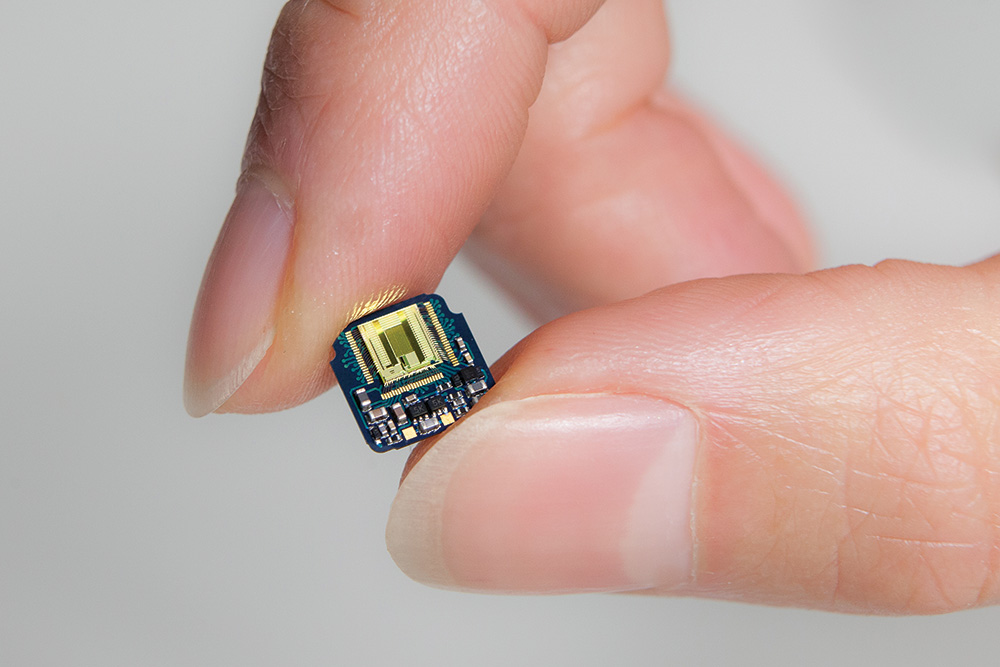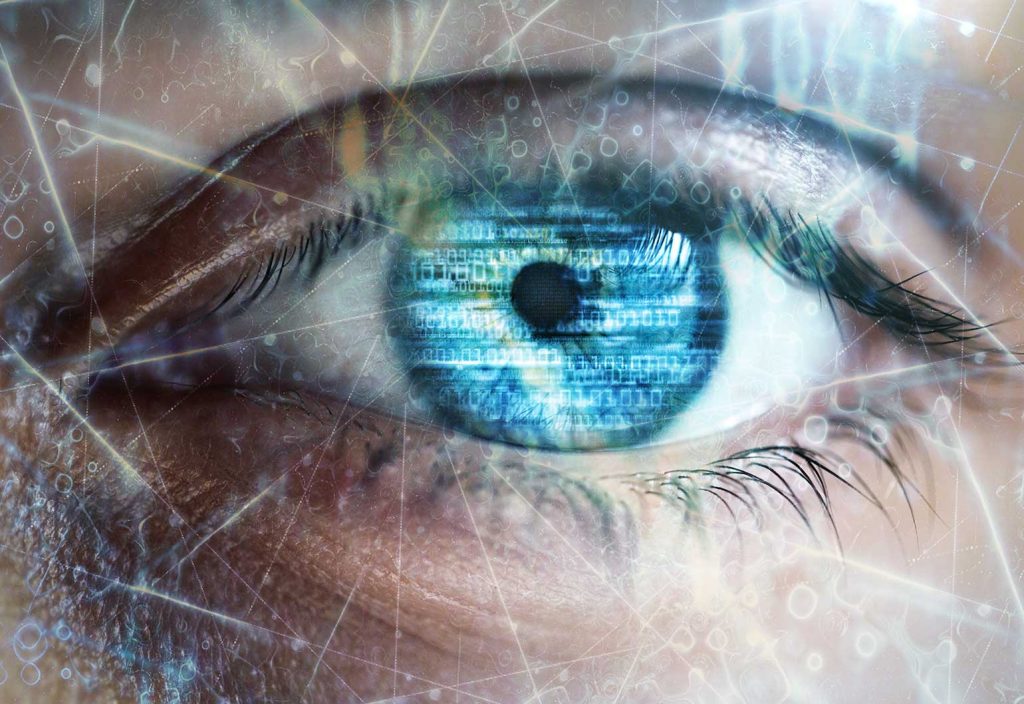Neurotechnology could deliver revolutionary results for people with vision loss. One Melbourne bionic eye prototype works in sheep, but is it ready for humans?
Earlier this year, Neuralink, one of Elon Musk’s companies, released a video of a monkey sitting in front of a computer screen and playing a game of Pong with just its mind.
The technology behind it is a coin-sized chip that, when implanted into the brain, connects thousands of polymer threads to neurons and enables electrical stimulation.
Musk described the device as being “like a Fitbit in your skull”, claiming it will one day be able to address everything from paralysis to depression and, ultimately, integrate with artificial intelligence.
But while Musk’s company might be the loudest, it’s not the only one making inroads in neurotechnology.

Monash University’s Professor Arthur Lowery has been working on related technology since 2009.
Head of the Monash Vision Group (MVG), Lowery and his multidisciplinary team have developed a prototype that promises to restore visual perception to people who have lost their sight — in other words, a bionic eye.
The Monash team — dubbed Cortical Frontiers — is one of several around the world developing this technology, which could have a revolutionary impact for people with vision loss.
Many of these projects revolve around a retinal implant, designed to be attached to the back of the eye, which sends information through the optical nerve.
The Monash team has taken a different tack. Their device — the Gennaris — features a 9 mm by 9 mm ceramic prism that’s implanted into the visual cortex, at the back of the brain.
“Where you might scratch your head,” as Lowery puts it.
“That’s the first access point into the visual pathway that doesn’t need the optic nerve or the eyeball,” he said.
Because many people who lose their sight have crushed or damaged optic nerves, for them, implanting the chip into the retina would not work. The Gennaris bypasses the potentially damaged ocular system and hooks straight to the visual cortex.
Just 3 mm thick and half the size of a fingernail, the prism holds 43 hair-thin electrodes that penetrate the brain to a precise depth.
To activate the device, the user simply slips on a pair of glasses that connect wirelessly to the brain implant.
A camera built into the glasses records the user’s environment.
A pocket processor translates the vision from the camera into electrical signals, which it directs to the implant via a wireless transmitter — a 60 mm coil — that rests at the back of the head.
The electrical pulses travel through the electrodes to stimulate the brain. With each pulse, the user perceives a phosphene — a bright spot of light.
Neuroscience meets engineering
With extensive experience in telecommunications, Lowery thinks like a systems engineer. Although he’s now delving into the brain, he sees this project as an extension of his previous work.
“Really, this is just like getting information from a camera,” he said. “As with all systems engineering, you’ve got to make sure all the parts talk to one another.”
The Cortical Frontiers team spans several disciplines and includes physiologists, medics, surgeons, electrical engineers, mechanical engineers, mathematicians and software engineers. The device’s headwear was designed in collaboration with Monash’s Faculty of Art, Design and Architecture.
Biomedical engineer Dr Yan Wong, head of the Monash Neurobionics Laboratory, joined the project in 2017.
“I work at the intersection between neuroscience discovery and engineering,” he said.
Wong said a big challenge for the field is matching engineering capability with current limitations in neurological knowledge.
“We can design some of the coolest implants in the world, some really, really technologically advanced stuff,” he said. “But we have these fundamental gaps in knowledge when it comes to how our brain works: how does the visual part of our brain actually allow us to see and perceive the world?”
“Everyone’s brain is different,” added Lowery.
“All our neurons — it’s like a bowl of spaghetti bolognaise.”
Seeing stars
Lowery said the bright spots of light that Gennaris users perceive are like the dots in “very early radar”.
“I often describe them as kind of like a star in the sky, or a grain of rice at an arm’s length,” Wong said.
The Gennaris can generate patterns of up to 172 phosphenes. While the device can’t restore full vision, it sends the user important perceptive information, which can help them navigate the world.
They might be able to perceive the dotted outline of a person approaching, or the edges of objects in the room around them. The hope is that a user’s brain will gradually learn to more fully harness this information.
“Over time, the brain might get better at interpreting the information it receives,” Lowery said. “Initially we’ll see dots, but then we’ll work out that those represent places or buses, or trams, cars, footpaths.”
Ready for humans?
The team has completed pre-clinical trials in sheep, with results published in the Journal of Neural Engineering in July 2020.
Ten devices — seven active and three passive — were implanted into the sheep, with stimulation delivered for up to nine months for a cumulative total of 2700 hours.
“This long-term study showed our devices could last in the harsh environment of the brain and don’t have any kind of detrimental effects when implanted into an animal,” Wong said.
The team is now seeking additional funding to progress to human trials.
Supporting the technology’s business case is the fact that it could have numerous applications aside from visual perception, including treatment for chronic pain, depression, and memory loss.
“We can implant in different parts of the brain to try and alleviate different types of symptoms,” Wong said.
“One of the applications we’re looking at is for quadriplegic or upper limb amputees. We can use the same kind of device and record thoughts from the motor cortex, then stimulate the next area, the somatosensory cortex.
“So, when someone reaches out with a robotic arm and lifts something, we can stimulate in the somatosensory cortex and tell them that they’ve touched something.
“And this is not science fiction. People are doing this overseas — but mostly with wired devices, which limits the lifetime of those devices.”
Funding is still a major hurdle for the technology. The project received federal funding, as well as private donations, but it will need to secure more before proceeding to human trials, which the researchers hope can happen in the next five years.
They say having figures like Elon Musk on board is useful for the field as a whole. While Musk’s claims may be sensationalist, the hype generated by ventures like Neuralink could translate into more investment.
“That kind of thing really changes how we do our work: it brings another level of professionalism in terms of manufacturing; it brings a different scale of funding to our work,” Wong said. “People start to ask: how do we push the field truly forward? And that helps everyone. Their discoveries help us, and our discoveries will help them.”
The technology certainly has a way to go before it is widely accessible, but decades down the line, it could restore full vision — if scientific knowledge of the brain keeps pace.
“What we really want to do is move from this kind of pixelated vision — ‘stars in the sky’ — to the rich tapestry of the world,” Wong said. “But we’ll need to uncover these really fine details about how our brain works, and allows us to see, before we can design the implant to fully restore that.”
Other ways of seeing
The Monash Vision Group is not the only team working with bionic eye technology.
French company Pixium Vision recently announced the first human implants of its Prima System, a wireless sub-retinal implant. The clinical trial is working specifically with patients with dry age-related macular degeneration.
The US-based Second Sight implanted its first retinal prosthesis, the Argus II, in 2007. It is designed to restore visual perception to patients with retinitis pigmentosa and has been used by 350 people globally.
The company is currently working on cortical stimulation technology similar to the Monash team.
Pixium and Second Sight had planned to merge, but the deal recently fell through.
